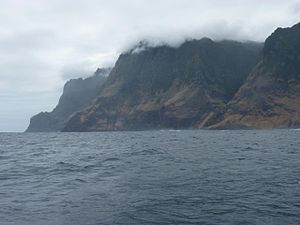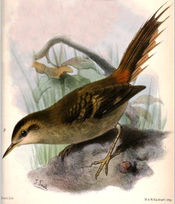- Alejandro Selkirk Island
-
Alejandro Selkirk Island, previously known as Isla Más Afuera and renamed after Alexander Selkirk, is the second largest and most westernly island of the Juan Fernández Islands archipelago of the Valparaíso Region of Chile. It is situated 181 kilometres (112 mi) west of Robinson Crusoe Island in the southeastern Pacific Ocean.
Contents
Name
In 1966, the Chilean government renamed Isla Más Afuera to 'Alejandro Selkirk Island,' with Isla Más a Tierra becoming 'Robinson Crusoe Island.' Alexander Selkirk was a Scottish sailor who was marooned as a castaway on Isla Más a Tierra (then uninhabited) from 1704 to 1709. His story of survival inspired the 1719 novel Robinson Crusoe by Daniel Defoe.[1]
Geography
The island measures 11 kilometres (7 mi) north-south and 6 kilometres (4 mi) east-west, and has an area of 44.6 square kilometres (17 sq mi). It is densely wooded and very mountainous and is marked by ridges and numerous deep ravines lead to a steep-to, rugged coast on the east side of the island off which are tremendous depths. The coastal cliffs are up to 1,000 m (3,281 ft) high. The south, west and north sides of the island have sandy strips of beach which extend 0.1 mi (0 km) offshore in places. The highest peak, Cerro de Los Inocentes, rises to 1,329 m (4,360 ft) at the of the southwest side of Alejandro Selkirk Island, and at the southwest extremity there is a prominent rock with a hole through it.
Landing is possible near the center of the east shore at Quebrada Sanchez, and at the foot of Quebrada Las Casas 33°45′S 80°43′W / 33.75°S 80.717°W), where there is a boat slip and buildings of the former penal colony. Anchorage can be taken about 0.3 mi (0 km) ENE of Quebrada Sanchez (33°43′S 80°44′W / 33.717°S 80.733°W), in depths of 40.2 m (132 ft) to 49.4 m (162 ft). The ravine is recognized by a white patch on a hill near it. Anchorage can also be taken, in depths of 31.1 m (102 ft) to 50 m (164 ft), with sand bottom, off Rada de la Colonia.[2]
Dating of the rocks on the island show that it is the youngest of the Juan Fernández Islands at an age between 1 or 2 million years old. Due to its age, the island has had a little erosion.
About 59 kilometres (37 mi) southwest of the island is submerged Sefton Reef (36°43′S 83°15′W / 36.717°S 83.25°W), almost reaching sea level, and 47 kilometres (29 mi) northwest Yosemite Rock (32°04′S 83°14′W / 32.067°S 83.233°W). Podesta Island reported further west is a phantom island.
Fauna
The Juan Fernández Fur Seal is known to have existed during the late-17th century on the island with the population of the seals on Alejandro Selkirk Island and Robinson Crusoe Island believed to be in excess of four million by the late 17th century. A census of 1797 estimated a population 2–3 million fur seals.[3] The species was hunted to near extinction by the 19th century and was thought to be extinct for 100 years until 200 were found on the island in 1965. Since then, the population has grown at a steady rate of 15–20% every year.[4] The Masafuera Rayadito is endemic to Alejandro Selkirk and one of the rarest South American birds with only 140 individuals left.
Flora
The flora on the island is in the Fernandezian Region Floristic Region, in the Antarctic Floristic Kingdom, but often also included within the Neotropical Kingdom. Endemic plant families include Lactoridaceae, with endemic plant genera also found.
Settlement
The island is currently uninhabited. There is a former penal settlement on the middle of the east coast, at 33°45′49″S 80°45′27″W / 33.76361°S 80.7575°W. About 20 buildings can be made out on detailed satellite images.[5] The settlement was operative from 1909 to 1930. It initially housed 190 criminals. From 1927 to 1930, there were 160 political prisoners on the island.[6]
See also
- Flora of the Juan Fernández Islands
- Endemic flora of the Juan Fernández Islands
- Endemic fauna of the Juan Fernández Islands
References
- ^ Dieter Mueller-Dombois; Francis Raymond Fosberg (1998). Vegetation of the Tropical Pacific Islands. Springer. p. 610. ISBN 0387983139.
- ^ Sailing Directions Enroute, Vol. 125, West Coast of South America
- ^ Ronald M. Nowak (1999). Walker's Mammals of the World. JHU Press. p. 846. ISBN 0801857899.
- ^ A. Rus Hoelzel (2002). Marine Mammal Biology: An Evolutionary Approach. Blackwell Publishing. p. 330. ISBN 0632052325.
- ^ Satellite image
- ^ Maura Brescia de Val (2004). Selkirk Robinson: El mito: a tres siglos del desembarco del solitario en Isla Robinson Crusoe (1704–2004). Mare Nostrum. p. 245. ISBN 9568089047.
External links
- Robinson Crusoe, Moai statues and the Rapa Nui: the stories of Chile’s far-off islands
- Geographical names on Alejandro Selkirk Island
Coordinates: 33°45′04″S 80°47′00″W / 33.75111°S 80.7833333°W
Categories:- Juan Fernández Islands
- Uninhabited islands of Chile
Wikimedia Foundation. 2010.



